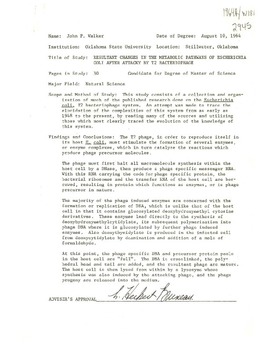| dc.contributor.advisor | Bruneau, L. Herbert | |
| dc.contributor.author | Walker, John P. | |
| dc.date.accessioned | 2016-02-24T21:37:45Z | |
| dc.date.available | 2016-02-24T21:37:45Z | |
| dc.date.issued | 1964-08 | |
| dc.identifier.uri | https://hdl.handle.net/11244/31622 | |
| dc.description.abstract | Scope and Method of Study: This study consists of a collection and organization of much of the published research done on the Escherichia coli, T2 bacteriophage system. An attempt was made to trace the elucidation of the complexities of this system from as early as 1948 to the present, by reading many of the sources and utilizing those which most clearly traced the evolution of the knowledge of this system. | |
| dc.description.abstract | Findings and Conclusions: The T2 phage, in order to reproduce itself in its host E. coli, must stimulate the formation of several enzymes, or enzyme complexes, which in turn catalyze the reactions which produce phage precursor molecules. | |
| dc.description.abstract | The phage must first halt all macromolecule synthesis within the host cell by a DNase, then produce a phage specific messenger RNA. With this RNA carrying the code for phage specific protein, the bacterial ribosomes and the transfer RNA of the host cell are borrowed, resulting in protein which functions as enzymes, or is phage precursor in nature. | |
| dc.description.abstract | The majority of the phage induced enzymes are concerned with the formation or replication of DNA, which is unlike that of the host cell in that it contains glucosylated deoxyhydroxymethyl cytosine derivatives. These enzymes lead directly to the synthesis of deoxyhydroxymethylcytidylate, its subsequent polymerization into phage DNA where it is glucosylated by further phage induced enzymes. Also deoxythymidylate is produced in the infected cell from deoxycytidylate by deamination and addition of a mole of formaldehyde. | |
| dc.description.abstract | At this point, the phage specific DNA and precursor protein pools in the host cell are "full". The DNA is crosslinked, the polyhedral head and tail are added, and the resultant phage are mature. The host cell is then lysed from within by a lysozyme whose synthesis was also induced by the attacking phage, and the phage progeny are released into the medium. | |
| dc.format | application/pdf | |
| dc.language | en_US | |
| dc.rights | Copyright is held by the author who has granted the Oklahoma State University Library the non-exclusive right to share this material in its institutional repository. Contact Digital Library Services at lib-dls@okstate.edu or 405-744-9161 for the permission policy on the use, reproduction or distribution of this material. | |
| dc.title | Resultant changes in the metabolic pathways of Escherichia coli after attack by T2 bacteriophage | |
| osu.filename | Thesis-1964R-W181r.pdf | |
| osu.accesstype | Open Access | |
| dc.type.genre | Master's Report | |
| dc.type.material | Text | |
| thesis.degree.discipline | Natural Science | |
| thesis.degree.grantor | Oklahoma State University | |
